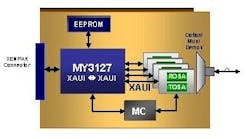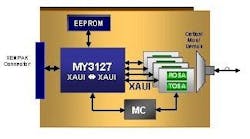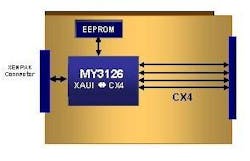Today's 10-Gbit/sec transceivers meet the rapidly evolving requirements of the enterprise
However, a broad perspective helps when choosing between copper and optical offerings.
Amir Bar-Niv and Dimitry Taich
Mysticom Semiconductor
Within the enterprise today, customers are attempting to integrate gigabit applications, implement greater network management and security, and remove server bottlenecks. Already, deployment of 1-Gbit/sec speeds to the desktop are rapidly accelerating the need for faster interconnects between switches, routers, and servers. Use of multiple (four or two) uplink connections at 1-Gbit/sec speeds causes a serious bottleneck, hindering the full-scale deployment of gigabit switching in the enterprise.
Meanwhile, "content provider" data centers also demand high-speed interconnects. The exponential growth of subscribers, coupled with the migration from 56-kbit/sec modems to DSL and cable-based broadband access in the 1-Mbit/sec range, creates a bottleneck between switches/routers and their associated storage for content. In the realm of server farms, increased CPU horsepower, faster peripheral interconnects, and faster intra-connect buses (PCI-X and PCI-Express) leave the server network interface as the primary bottleneck.
All of these applications would benefit from the introduction of 10-Gbit/sec links. But when evaluating today's 10-Gbit/sec technology, or offerings that are around the corner tomorrow, it is advantageous to take a 30,000-ft. view to examine such issues as: How do fiber and copper solutions each address the enterprise? What are the advantages and challenges of each solution? How will market segments continue to evolve? And, finally, what is the progress of each of the standards efforts that will affect the industry over the next several years?
Optical and electronic
Product for 10 Gbits/sec is now available under two IEEE standards -- LX4 and CX4. 10GBASE-LX4 is based on the XAUI interface (four channels of 3.125 Gbits/sec each) and uses WDM to send signals over four wavelengths on a single fiber. Designed to operate with optical transceivers centered at 1310 nm, this solution operates at distances of 2 to 300 m over deployed multimode fiber for in-building applications.
Comparatively, 10GBASE-CX4, also based on four channels of 3.125 Gbits/sec, is a copper breakthrough at the 10-Gigabit PHY layer. CX4 enables cost-effective 10-Gbit/sec uplinks for connections between stackable switches over short distances, which is the highest volume segment for 10-Gigabit Ethernet applications, and can also be used effectively in data-center applications over longer reaches with the right planning and architecture. Before CX4's recent introduction, the only 10-Gbit/sec options available involved optical links. Using copper cable for short distances provides highly reliable, yet low-cost alternatives to its optical counterpart.
Recently at CeBIT in Hannover, Germany, Cisco announced support for both 10GBASE-LX4 for long-reach enterprise applications over multimode fiber for wiring closet connections and10GBASE-CX4 for short-reach interconnects over copper. The announcement added a high degree of legitimacy for both LX4 and CX4, and a strong indication that copper and fiber solutions will coexist well into the future.
Enterprise long-reach solutions
The 10-Gbit/sec long-reach segment of the enterprise includes both vertical riser and horizontal interconnects up to 300 m. Other than for new construction, it is not anticipated that building backbone fiber will be upgraded; consequently, operation will primarily occur on currently installed 62.5- and 50-micron multimode fiber. Two alternatives are now available to address the segment -- 10GBASE-SR and 10GBASE-LX4.
10GBASE-SR uses 850-nm lasers for 10-Gbit/sec serial transmission over multimode fiber. Multimode fiber is relatively inexpensive, yet due to dispersion problems, it can present performance issues. With 10GBASE-SR, signals can be sent with an acceptable bit error rate (BER) over a distance of 30 m on low-grade fiber, reaching 80 m on better grades of fiber -- a far cry from the 300 m necessary to cover 90% of the installed base (a figure derived from an IEEE study). Implementing electronic dispersion compensation in the future is anticipated to improve signal recovery on the receive side, and therefore distances. The goal of new standards being defined is to achieve 220 m over low-grade fiber.
Conversely, LX4 over multimode fiber is available now and effective over a distance of 300 m. Composed of four links, each of 3.125-Gbit/sec multiplexed using CWDM, LX4 is available in plug-and-play XENPAK, X2, and XPAK form factors for easy deployment or upgrade with existing switch, router, and server equipment. Current LX4 PHY transceiver ICs provide high integration and low power, facilitating small form factors (Figure 1). Recently announced ICs also integrate XENPAK/MSA registers, advanced digital optical monitoring (DOM) registers, and even the oscillator function -- virtually all electronics on chip.
Enterprise short-reach options
The 10GBASE-CX4 standard, completed in February 2004, was designed to resolve the price challenges of delivering 10-Gigabit Ethernet. Providing 10x the speed at 3x the cost of the 1-Gigabit technology it replaces, the PMD more than delivers on its promise. The CX4 standard specifies distances up to 15 m and is the first solution for 10-Gigabit Ethernet over copper cabling. What's more, CX4 is based on a known technology -- the XAUI interface -- which is well adopted and accepted on backplane interconnects.
However, to ensure reliable operation over challenging InfiniBand cable, the standards committee placed additional requirements on CX4 compared with XAUI. These include amplification of the high-frequency components of the transmit signal (pre-emphasis), limitations on amplitude, and tightening of jitter requirements.
The CX4 cable was adopted from the InfiniBand standard, immediately creating a pool of vendors for the connectors and cables for this application. CX4's advantages are simplicity and low cost -- a full 80% less expensive than an optical solution. Simplicity, although secondary to cost, results from an end-to-end electrical solution that eliminates complex optical components and increases system reliability.
The primary challenge for CX4 transceiver ICs results from the copper media. Besides well-known attenuation issues, the low-frequency characteristics of the copper communication channel demands the application of advanced equalization techniques to prevent severe performance degradation. Compounding matters further, return signals originating at CX4 connectors and near-end and far-end cross talk (NEXT/FEXT) phenomena raise the bar even higher. In addition, field deployments have to deal with a variety of cables and connectors from multiple vendors with different characteristics, which in some cases may not even conform to the standard specifications. Consequently, implementations must have sufficient performance margin to accommodate these impairments and variations.
Recently announced ICs deal with impairment issues extremely well, using modern post-processing techniques to clean the received signal (Figure 2). The inter-symbol interference (ISI) impairment is treated by applying a minimum amount of signal equalization on the transmitter side (also known as pre-emphasis), as well as a receive-side equalizer. This separated approach allows a sufficient amount of high-frequency gain to cope with worst-case InfiniBand (copper) cable challenges, while keeping power consumption to a minimum. ICs currently on the market offer programmable parameters such as amplitude, pre-emphasis, and impedance, in addition to customary equalization. These devices can support transmission distances of 30 m (twice the 15 m specified in the standard), as well as the use of thin, cost-saving 26, 28, and even 30 AWG cable.
On the drawing board
As mentioned previously, the inherent limitation on the distance (a few tens of meters on low-grade fiber) of 10GBASE-SR is driving the industry toward 10-Gbit/sec serial offerings that approach 300 m. An IEEE study group has begun to look at implementing electronic dispersion compensation (EDC) to extend the reach of transceivers over multimode fiber up to 300 m. Known as 10GBASE-LRM, the group intends to provide a transceiver specification that will compensate for the interferences caused to signals by dispersion and other fiber impairments (launch conditions, vibrations, etc.) and enable the inherent simplicity and economies of scale provided by serial technology.
The charter is for a solution based on a 1310-nm laser that will enable transmission over low-grade multimode fiber of up to 220 m, and 300 m on select multimode fiber. The committee is scheduled to complete the standard by year-end 2005, with ratification likely in 2006. Significant work remains, however, including a quantified definition of media impairments, development of an open-source Matlab model for the link, definition of testing procedures, etc. The challenge is to create a specification that keeps the power budget and cost low. In the meantime, LX4 will remain a viable alternative for enterprise applications to 300 m, spanning almost the entire installed base of fiber.
Simultaneously, another IEEE task force called 10GBASE-T is studying the feasibility and implementation options for transmitting and receiving 10-Gbit/sec signals on common unshielded twisted-pair cables. Originally targeting the installed base of Cat 5/5e (100 m), to run 10-Gbit/sec all the way to the desktop, the task force decided that the throughput is beyond the capacity of these cables.
10GBASE-T is now slated to run over higher-quality cable -- Cat 6 (up to 55 m), and Cat 7 (up to 100 m). The change in focus reduces the attraction of the potential standard. In addition, there are huge technical challenges, including complex analog front-end technology and heavy digital signal processing (DSP) compute requirements, all with low power consumption. This necessitates advanced semiconductor process technology. The combination of these challenges results in the expectation of a standard no sooner than three years from now, with deployable product some time after that. Consequently, CX4 is likely to remain the only viable 10-Gbit/sec copper alternative for several years.
Summary
Bandwidth requirements based on content-rich applications and the addition of more intelligence and capabilities to the enterprise network necessitate a rapid move to 10-Gbit/sec interconnects. LX4 facilitates a low cost of ownership by enabling the use of installed multimode fiber. CX4 provides 10-Gbit/sec speeds over copper at unprecedented cost savings.
Although several standards-based fiber and copper alternatives are in the wings, it is expected that most of the solutions currently on the drawing board will at best take several years to produce product. In the meantime, LX4 represents a viable enterprise long-reach solution while CX4 effectively resolves the price challenge of delivering 10 Gbits/sec to stackable switch connections as well as a large percentage of data center needs.
Amir Bar-Niv is director of applications and Dimitry Taich is applications manager, Multi-Gigabit Product Line, at Mysticom Semiconductor (Mountain View, CA).

